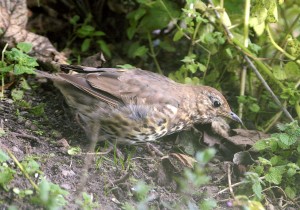 In the Highlands we tend to forget that some song thrushes are migrants in the same way as fieldfares and redwings. It highlights what is in fact a rather mysterious bird despite the song of the song thrush being one of the aspects of the early dawn chorus. Despite this vocal dominance in the spring, for much of the rest of the year the birds are rather secretive and in many cases seldom seen for any length of time and they often go un-noticed. The bird is smaller than the blackbird with a relatively short tail with brown upperparts and small black spots over its breast and flanks. The only other bird with a similar plumage is the mistle thrush but these are much larger and in flight they have white under the wings as opposed to the orange of the song thrush.
In the Highlands we tend to forget that some song thrushes are migrants in the same way as fieldfares and redwings. It highlights what is in fact a rather mysterious bird despite the song of the song thrush being one of the aspects of the early dawn chorus. Despite this vocal dominance in the spring, for much of the rest of the year the birds are rather secretive and in many cases seldom seen for any length of time and they often go un-noticed. The bird is smaller than the blackbird with a relatively short tail with brown upperparts and small black spots over its breast and flanks. The only other bird with a similar plumage is the mistle thrush but these are much larger and in flight they have white under the wings as opposed to the orange of the song thrush.
The distribution of the song thrush in the Highlands is confusing. Breeding birds occur in many parts of the Highlands but tend to move to lower ground or to the coasts in the winter. Migrant birds come in from late August onwards and spread through the lower ground. Part of the confusion arises from the presence of a subspecies of the birds that occurs in the Outer Hebrides and the Isle of Skye. This is supposedly an endemic bird which means it occurs in no other part of the world. There is a great deal of debate as to whether it occurs on Skye. The total numbers of song thrushes breeding in Scotland is estimated as 250,000 pairs with a wide variety of estimates of what is often called the Hebridean song thrush.
What is unclear about the breeding pairs of the song thrush in the Highlands and around Inverness is the variation of numbers in the last decade or so. For example three or four years ago the bird was so scarce around Inverness that to see one was worth noting. Last year, and even more so this year, the numbers of breeding pairs and their success have increased. Whilst the decline of other birds can be put down to migration and the problems this causes, the song thrush does not come under this category. It was the marked decline in lowland areas that was particular cause for concern. This was particularly the case in the eastern areas where drainage led to problems with food supply for the birds. There is also the continuing threat of the loss of permanent fields grazed by stock and the overall loss of hedges and damp areas. The song thrush in the Highlands has had a mixed history as at one time they were eaten and a cookery book of around 1940 indicates their former use in the kitchen
The photograph was taken in a garden in Inverness and the bird is in the typical pose as it forages amongst dense vegetation. The bird is a juvenile as the yellow “gape” at the base of the beak indicates. Interestingly song thrushes very rarely come to feeding stations in gardens even for mixed seed on open feeders or on the ground. Perhaps the most fascinating record of the food of these birds is of them mixing with purple sandpipers and collecting winkles on the shoreline. They treat them in the same way as snails in that they bash them on rocky anvils. There are five Scots names including mavie, mavis and thissel cok. There are three Gaelic names with perhaps the most appealing being “Smolac” meaning ember. The others are “Smeorach” and “Ciarsach” meaning song thrush and dusky one.
